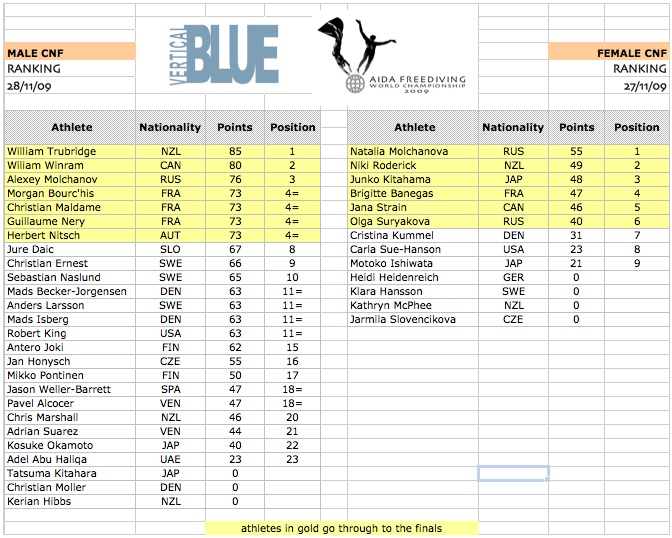 |
 |
Aida depth World Championships in Bahamas 2009
Before you read the somewhat dry pressrelase below, lets´sum it up in a more informal, straightforward and critical way.
- We did not see Sara Campbell challenge Natalja in depth.
- Natalja was untouchable in both CWT and CNF - which made the battle for the gold very boring.
- Apart from the obvious two above we did see only two women above 70 meters. Is female freediving lagging behind?
- New Zealander Mullins did not turn up to claim a medal in CWT.
- Stepanek would not enter a world championship side by side with Herbert unless he has time to train, he just showed up and coached his partner Nikki Roderick to a silver in CNF.
- Kathryn McPhee (NZL) could not transfer her poolskills into top level depth achievements.
- Annelie Pompe has not been seen freediving for a year and the wispers of her passing 80 CWT has faded.
- Very ambitious and talented Kerian Hibbs failed just as he did in Aarhus, so much potential, came to nothing in ranking.
- Canadian Jana Strain did not, as we wanted, amaze us in CWT.
- Ryouzo turned early, and the japaneese filmcrew did not show any dissapointment (one does not do that in asia), nor did they seem to bother to turn their cameras to any of the japaneese women doing personal bests and national records.
- Under water channel went bankrupt and the ambitious plans of "daily video online updates" failed.
- Chief organizer forgot his head and the medals and the award ceremony was without medals. Has never happend before, what a scandal.
- No organized way of efficient selling selling mediamaterial to the athletes.
- The smallest WC ever and the most expensive for the athletes.
|
But we did see: - Carlos Coste fully back in the "champions league" with a 110 meter bronzemedal. - Winram actually diving extremely deep (not just talking about it), 86 meter CNF silver. - Another diver in the 100 meter club (Johan Dahlström). - Media money actually coming into the sport. - And a money sponsor. - The most supervised and controlled competition area we have ever seen. |
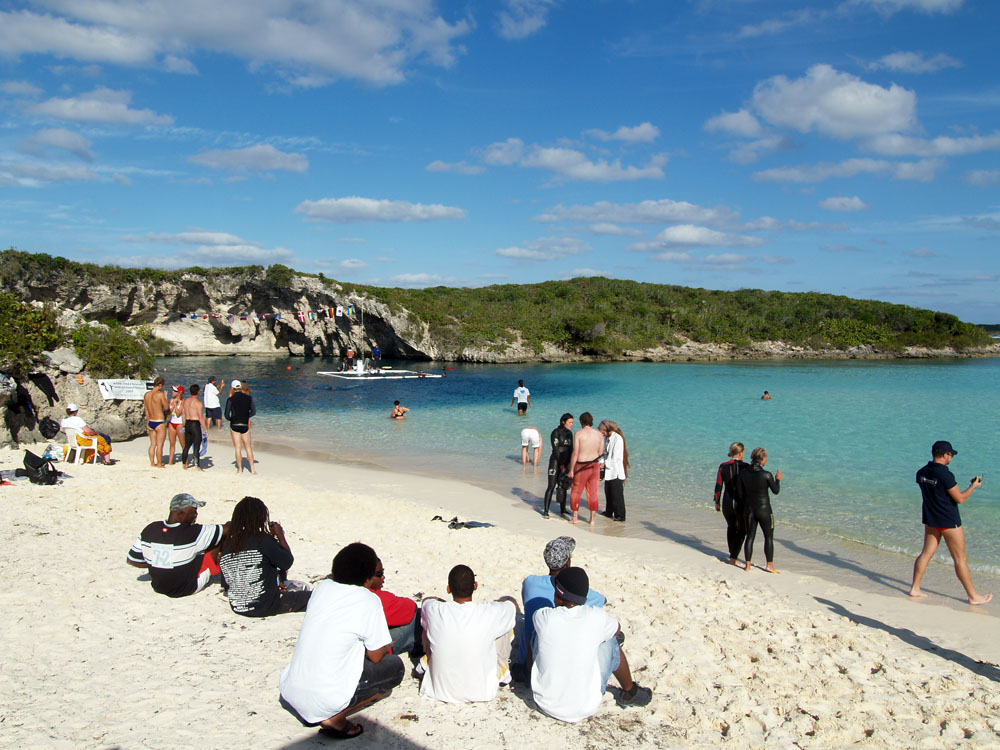 |
- Alexey pulling of a PB with 111 CWT getting a silver medal after a sloppy SP.
- The french men in sporty Sony suits, playing the game awfully well and doing very controlled dives.
- A promptly updated site with results and photos.
- A bold CNF 89 meter dive by Herbert not having trained for it (failed surface protocol. Two ok signs).
- That even if Trubridge is better than ever, he is not untouchable.
- More national records than I bother to count (thanks mainly to extra comps on the rest days).
- Less BO´s than expected (8%)
- Lots of professional cameras everywhere.
- Very few discussed judge calls and only two protests.
- The assembly being flexible allowing only three judges which proved enough.
|
PRESSRELEASE - Aida individual world championships in freediving 6th november 2009 Extreme depths at the Aida individual world championships in freediving - 2009 Bahamas. Gold medals in the no fins category landed as predicted with the current world record holders: William Trubridge and Natalja Molchanova. |
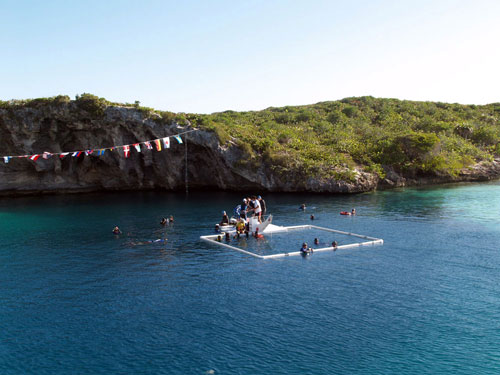 |
In the classic fin category (CWT) nobody could challenge ruling champion Natalja Molchanova - and as expected Herbert Nitsch took the gold medal.
The drama was around the silver and bronze medals.
The world championships started with record depths demanded for a place in the final in the no fins category. Three french men announced the same depth - 73 meters (which became the qualifying depth), forcing the organization to include them all in the final. It was no surprise that the ruling world record holder William Trubridge announced the deepest depth in the final. The plate was lowered to 90 meters depth where no light reaches down. Before that the crowd on the beached had seen the Austrian Herbert Nitsch try for a world record depth of 89 meter, making it down there in a 3.40 minute dive, but failing to deliver correct surface protocol to the judges at the surface, due to low oxygen and lack of focus (and lingering narcosis). Trubridge compeeting on "home turf" did a very secure dive to 90 meters leaving the competition behind. The Canadian William Winram did an impressive come back, with first an 80 meter dive in the heats, and then 86 meter in the final, claiming the silver medal. Due to young Alexey Molchanovas short black out at the surface after a 83 meter dive, the french man Guillaume Nery took the bronze with a 78 meter dive - and remember, these are dives done with breast strokes down and up.
Among the women Natalja Molchanova was out of reach for the other women with her 62 meter no fins dive lasting 3.15. Nikki Roderick, New Zealand, claimed silver with a 55 meter dive (coached by her partner the multiple world record holder Martin Stepanek). Jana Strain Canada kept within her limits, not pushing it too far as has happened before, took the Bronze medal with a 54 meter dive coming up with blood from the sinuses.
But no one was as happy as Junko Kitahama finishing 4th with a 52 meter Japanese record (leaving her coach crying happy tears). Junko having progressed nearly 10 meter during the training week preceding the World championship.
Constant Weight dives (CWT = with monofin).
After an early turn from Jana Strains, leaving her out of the CWT (fins) final, Swedish Klara Hansson made it into the top 6 doing one of the many national records during this world championship. Japaneese Misuzu Hirai managed two national records in this competition and finished 4th with a dive to 72 meters. Jarmilla Slovencikova from Czeck republic did 74 meters national record and finished with a bronze.
Sara Campbell having lost motivation for really challenging the ruling Champion Natalja, did a (for her) easy dive to 92 meters. Natalja for the first time in years not announcing a world record depth in a world championship claimed the gold medal after a 97 meter dive.
For the men, in the classic fin category not even a 80 meter dive with monofin was enough to make it into the top 10. One of the favorites, the Japanese Ryouzo Shinomiya, turned early at 90, and missed the final, letting swedish Johan Dahlström into the top 6 and the final.
The final for the men was all clean dives, everyone making their announced depths from 101 to 114 meters. William and Carlos shared the bronze with a 110 meter dive (both deducting some 5 meters from training). Alexey Molchanov gambled with a high announcment and pulled of a 111 meter dive giving him a silver medal. Herbert Nitsch could comfortably claim the gold with a 114 meter dive. Without New Zealander Tom Mullins and Martin Stepanek in the competition, no one could really challenge him.
The Blue Hole in Long Island proved to be perfect place for performance freediving. Calm, deep, warm waters a few swim strokes from land. 51 athletes from 17 nations participated making it one of the smallest World Championships, but at the same time one of the most successful in the sense of depths achieved and number of national records.
|
World records William Trubridge BO percentage 8% DQ percentage 10% |
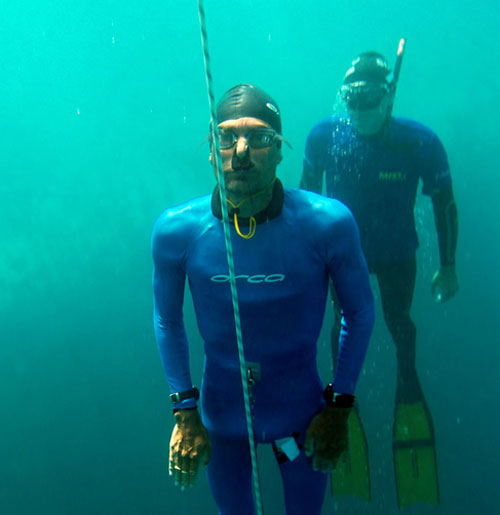 |
For a freediver it is not only a question of being able to equalize and hold your breath for a long time. You must have lungs that can tolerate the depths.
You run the risk of pulmonary edema (among freedivers: Squeeze). lung squeeze is when fluid from the blood goes through the gas barrier (membranes in the alveolis) and get into the lungs. The respiratory system is impaired, you have less uptake of O2. You breath heavy for a long time after the dive, you are very tired and feel weak, there might be gurgling and weezing sound from deep down the throat when you breath out hard. You might cough and spit up traces of blood or pink foam.
During the WC 2009 in Bahamas chief organizer and competition doctor John Fitz Clarke took O2 readings by finger oxymeter from over 50 divers one minute after their dive. The body should be fully oxygenated in the artery system after only a few breaths. In a healthy person the readings should be above 97% saturation, or even a 100%. I (Sebastian) do not believe that bloodshift and vasoconstriction would linger and affect the readings. Since a oxymeter measures the color of the blood, blood is obviously in the finger if you get a reading.
Many strong-lunged divers come up with 96%+
The average value of the WC competitors where 88,7%
45% of the divers where at 90% or below.
Further evaluation of the results will be made.
|
The start It started long before the first competition day. Side by side every day on the diving platform the athletes are competing indirectly against each other during training days. Who is progressing towards a peak, who is wearing himself out, who adds meters in training, who is stopped by lost mouthfills, BO´s e t c? |
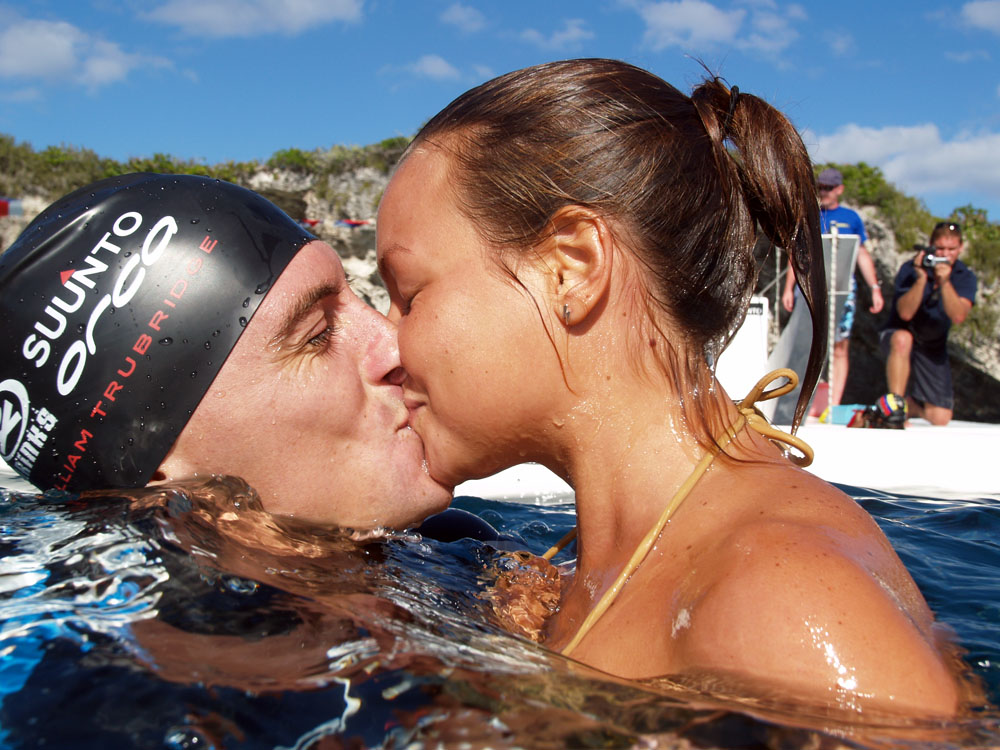 |
New suits are being tried out, new evaluation of weighting has to be done. Its about finding a peak in performance after months of training aiming for this one (or two) coming dives. And all the time the unspoken question: how much will it take to get into the final, to be among the top 6, that gets a second dive to change final ranking?
Some has arrived with personal goals. Maybe expressed in a general desire to improve and set a competition PB, or be among the ten best. Others want to get as close to a 100 meters, or break that barrier. We have seven athletes here that can dive to 100 meters with a monofin.
There have been some very ambitious athletes arriving early: William Winram, Jana Strain, Herbert Nitsch, Robert King, Johan Dahlstrom, Kerian Hibbs, and of course William Trubridge with the advantage of living here big parts of the year.
In a second wave we saw Guillaume Nery and the other french, Alexey Molchanov and Natalja Molchanova.
The atmosphere around the rope as usual friendly, relaxed with that underlying tension of being part of a group of people doing an adventure sport submerging to extreme depths. Depths that would gather the whole beach to watch some years ago are now done rather nonchalantly. As Christian Maldame pushing for 90+ setting of with only his safety Patrick B aware of the magnitude of the dive. Christian coming up slightly upset that his dive alarm preparing him for mouthfill at 30, beeped at 70.
Other athletes are more secretive about their training. William Winram always setting the rope at 100 (psychological reasons?) turning by feeling or depth alarm. And every day (almost) Trubridges´ dives done with lots of whisperings and hiding of rope markings by his line safety Kerian and morally supporting wife Brittany. We are talking 90´s here I believe.
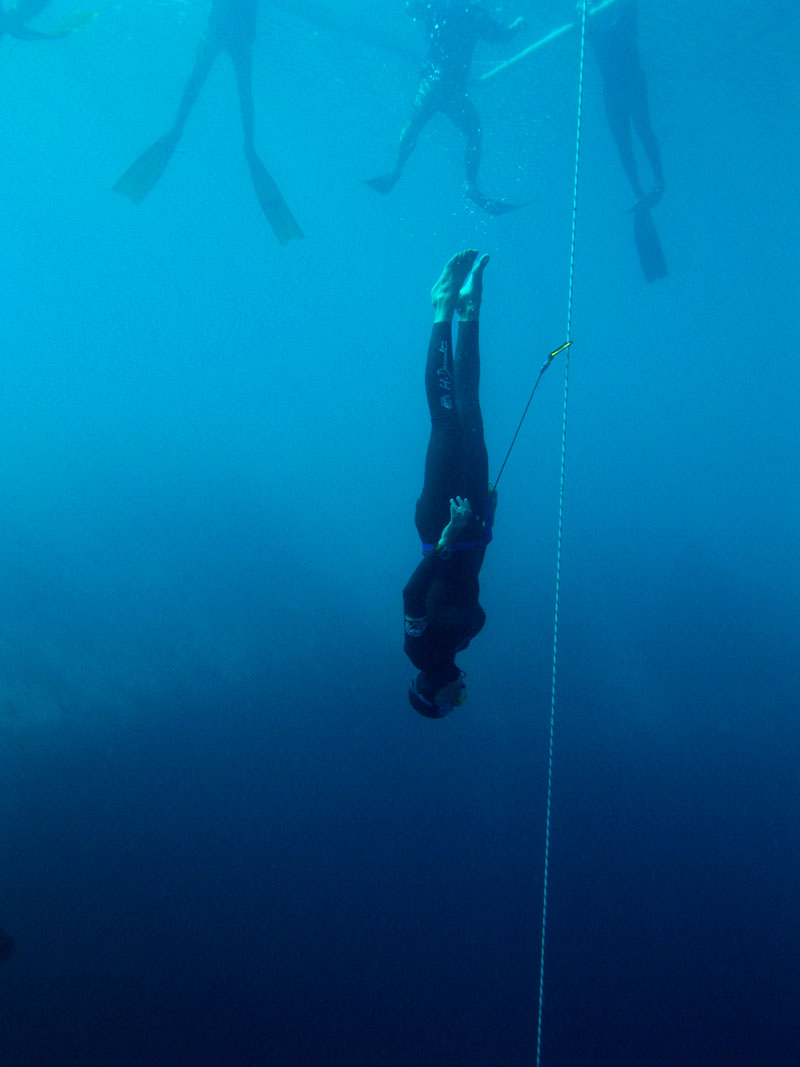
And day after day Herbert going down to 100 meters and usually pulling himself up, sticking to his strategy of only really pushing it on comp day. Most divers dive according to a 3 days diving and one day of. Guillaume Nery adding a day of after a confusing incident where he pushed himself in a 80+ dive in CNF, doing his inwater O2 deco for seven minutes breathing heavily after the dive - resulting in symptoms resembling DCS, but turning out to be hyperoxia.
Kathryn Mcphee trying to push her squeeze level deeper, Alexey Molchanov training at PB levels in CNF failing once due to too little rest, and then had another BO at a later try. He trains hard just up to the limit of his ability.
You can not get lost on Long island. There is one long paved road going on for hours. And while driving along this road you soon become aware of the many churches: assembly of god, first church of god, church of Christ, seventh day Adventists, Anglican church. One senses some level of competition here as well.
In such a "godfearing" country it seems appropriate that the opening ceremony started with an invocation by Father Ernest Pratt – St. Paul’s Anglican Parish.
But for the freedivers it is more like Umberto Pelizzari once said: "I seek god at the bottom of the ocean" (free quote). In this case the bottom of the Deans Blue Hole.
Sebastian Naslund, Chief organizer
VERTICAL BLUE
